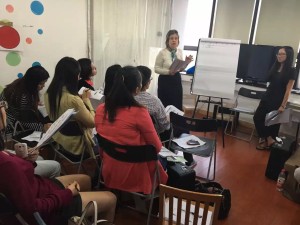 2015-12-11
2015-12-11
 Olivia's Place
Olivia's Place
 Comments Off
Comments Off
 Denise Challis, GMDS-ER, Griffiths Mental Development Scales - Extended Revised
Denise Challis, GMDS-ER, Griffiths Mental Development Scales - Extended Revised
In October, we were fortunate to receive training in Shanghai from Dr. Denise Challis (London-based pediatric neurologist of Great Ormond Street Hospital and the Portland Hospital and the most recent past chair of the Association for Research in Infant and Child Development (ARICD)) to use the Griffiths Mental Development Scales – Extended Revised (GMDS – ER). Dr, Challis visited LIH Olivia’s Place for the third time to train groups of clinicians from local services, all hoping to gain a better understanding of the measure and introduce it to improve identification and assessment of children through their clinics. At the October training many of LIH Olivia’s Place staff volunteered their own children for the group to practice with and over three days both the 0-24months and 36-96 months versions were taught and trialed.
Within a paediatric developmental setting it is best practice to use a range of tools to establish the level of a child’s functioning, guide future assessment and intervention, support a diagnosis and offer a means of comparing improvement and delay over time. Depending on the setting of the service, clinicians must rely on a varied range of information in order to move from the most basic identification of a problem in any area, through to accurate understanding, diagnosis and treatment.
Many scales have been developed over the past 70 years, each attempting to best quantify a child’s development across the age range. Patterns of assessment have emerged drawing on accepted practical ways of assessing ability (climbing stairs, catching a ball, naming objects) through to more complex ways of measuring understanding and emotion. For the majority of the development phases (the statistical analysis and creation of norms) western ideas and populations have been used to produce the test scores, interpretation and age equivalents.
Many other factors influence the choice of tests to use. Standardisation and quality of the scale is the obvious first level issue but frequently access to the test, style of the clinic in which you are working, time available and issues such as the population you work with are big influences.
Table 1: Overview of Tests
| Name of Test | Domains assessed | Nature of Test | Outcomes | Age Range | Norms available |
| 10 Questions | Brief overview of areas of difficulty. No formal scales, no standardized scoring system | Simple information about possible concern | |||
| Denver-11 | Personal/SocialFine Motor – AdaptiveLanguage
Gross Motor |
Standardised test with brief screening questionnaire and materials. | NormalSuspectUntestable | 0-6 years
0-72 months |
US Norms |
| Bayley-111 | CognitiveLanguageMotor
Socio-Emotional Adaptive Behaviour Scale |
Standardised test with good psychometric properties. Materials box | Derived scores (norm referenced scales, percentiles | 0-42 months | US Norms |
| GMDS | LocomotorPersonal-SocialHearing and Language
Eye and Hand Coordination Performance |
Standardised test with range of materials and training certificate required to use test to ensure adequate standards maintained | Month equivalent, percentile, z-score & confidence intervals | 0-96 months | UK norms & Chinese norms available this year |
For the Griffiths scale specialist training is required before the test will be released for use by a given clinician – this is to ensure that standards of conducting and interpreting the assessment are maintained and the validity and reliability of the scores can be protected. Doctors and psychologists are the only professionals permitted to independently administer the assessment, but selected therapists and educators who have been trained can administer parts of the assessment if they are working in a team led by a trained doctor or psychologist.
What is most exciting about the use of the Griffiths is that Dr. Challis, through several years of hard work with a number of leading medical universities in China, has developed norms for the Chinese population. ARICD has worked closely with a number of specialist centres across China and a UK statistician to create the norms and is in the final phases of creating the new normative data specifically for Chinese children. The findings were interesting in that they revealed different patterns of results for the Chinese vs UK populations. Chinese children were found to perform better on some academic measures while UK children have a different ability profile for motor and social skills.
LIH Olivia’s Place is working with the distributor of the Griffiths and is in the process of finalizing an agreement to serve as the distributor for the scales in China. From here we will continue to promote training and use of the instrument. Within LIH Olivia’s Place further discussion and planning can now be held about how to best use the tool within an integrated clinic pathway and to consider how it can direct interventions and measure progress. Undoubtedly there will be opportunities to share best practice with partners across China as well as consider the research data that may be revealed.



